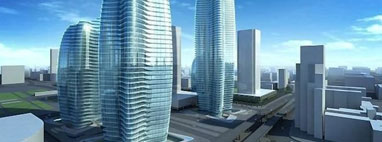125-year-old Skanska to Debut at EXPO REAL
This year marks Skanska’s 125th anniversary in the construction and development sector, and the first occasion when the company presents its global offer of green office buildings at the prime industry event of EXPO REAL in Munich.
Started in a basement in the Swedish town of Malmö, Skanska was initially a concrete production company. The firm soon evolved into a construction business, accomplishing many firsts in Sweden, including the first concrete bridge and the first asphalt road. By 1900, Skanska was present in the Nordic countries and Russia, to gradually enter more distant markets and become an international group. Today, Skanska is the world’s 5th biggest player in construction as well as commercial, residential and infrastructure development, and a pioneer in green building and innovation. The company’s home markets include Europe, the US and Latin America.
What Skanska brings to EXPO REAL are its green office developments in Central Europe, the Nordics and the US. Skanska Commercial Development has financed and developed about 1.9 million sqm (20.4 million sqf) of office space worldwide to date, and currently has about 425,000 sqm (4.5 million sqf) in the development pipeline. The global portfolio of green office buildings either completed, under construction or planned by Skanska includes projects in
21 cities in Central Europe, the Nordic markets and the United States.
“It’s great to be coming to EXPO REAL with a global portfolio of sustainable, future-proof office properties that not only offer flexible and efficient tenant solutions, but also deliver measurable long term value”, said Nicklas Lindberg, President, Skanska Commercial Development Europe.
The qualities shared by Skanska’s new office developments include green solutions applied to minimize their impact on the natural environment, at the same time ensuring a healthy working environment. The buildings are designed in a way that they use less energy and water and emit less CO2 throughout their life cycle, from selecting the location and sourcing materials, through the construction process to property management. Consequently, all Skanska office projects target LEED Gold certification or higher.
reen projects by Skanska Commercial Development – currently under construction or scheduled to be completed by 2015 – include:
Central Europe
Nordics
United States
Czech Republic
Balabenka, Prague
Nordica Ostrava, Ostrava
R6 Logistic Park, Prague
Hungary
Green House, Budapest
Nordic Light, Budapest
Poland
Atrium 1, Warsaw
Green Corner, Warsaw
Green Day, Wroclaw
Green Horizon, Lodz
Green Towers, Wroclaw
Kapelanka, Krakow
Malta House, Poznan
Romania
Green Court, Bucharest
Denmark
Nordhuset, Copenhagen
Plaza, Copenhagen
Scandport, Copenhagen
The Mayor, Copenhagen
Finland
Manskun Rasti, Helsinki
Sweden
Coop Extra, Sundbyberg
Entré Lindhagen, Stockholm
Fredriksdal, Stockholm
Green Tower Office Center, Gothenburg
Kährs Warehouse, Nybro
Klara Strand, Stockholm
LjungbyPorten, Ljungby
Polishus Roseng?rd, Malmö
Stockholm New, Stockholm
Tennet II, Gothenburg
The AF Building, Gothenburg
Torpavallen Retail Park, Gothenburg
Boston
150 Second Street
Houston
3009 Post Oak
Seattle
400 Fairview
Stone34
Washington D.C.
1776 Wilson Boulevard
733 10th Street
Skanska Celebrates its First 125 years
The year 2012 marks Skanska’s 125th year in business. Established in 1887 by the Swedish chemist and visionary constructor Rudolf Fredrik Berg, the company started off modestly as a concrete producer in a basement in the city of Malmö. The business soon scaled up to large concrete structures such as foundations and bridges, to evolve into a full-fledged construction company. A pioneer right from the start, Skanska delivered the first concrete bridge in Sweden, the first asphalt road, subway, as well as hydro and nuclear power plant projects.
International expansion soon followed – in 1897, concrete cable blocks were exported to the UK and by the beginning of the 20th century the company was established in Finland and Russia. When industrialization accelerated after World War II, Skanska became the prime supplier of roads and railroads, airports, industrial plants, offices and houses.
With the construction business bringing favorable returns, Skanska gained capital for its own development projects. The first investment ground was again Malmö, where a major property development was initiated in 1954, including hotels, offices, stores and residential units. Since then projects are being developed, built, and sold at a high pace, cashing in and re-investing in new offices, homes or Public Private Partnership projects such as hospitals and schools.
While Skanska-built projects can be found in plenty locations around the world, the company is focusing on being a leading contractor and developer in selected home markets: the Nordic countries, UK, Poland, Czech and Slovak Republics, Hungary, the US and a number of countries in Latin America. Management personnel in home market units are generally locals with in-depth knowledge of the country, while expertise and financial strength are global.
Since the mid-1990s, Skanska has continually increased its efforts for the well-being of the environment. Sustainability issues top the company’s agenda and since 2009 all new property development and investment projects must target LEED Gold environmental certification or higher. On this note, in 2008 Skanska remodeled and refurbished its flagship US office located on the 32nd floor of the Empire State Building, one of the highest and the oldest skyscrapers in New York, built in 1931. Now, the office not only provides a healthy work environment with fresh air and abundant daylight, but it is also significantly more energy efficient than before. That earned Skanska’s office LEED Commercial Interior Platinum certification, but more importantly, showcased the business sense of sustainability, with a four-year payback on the green refurbishment expense.

